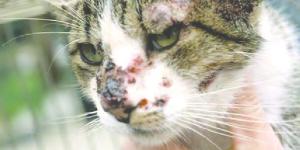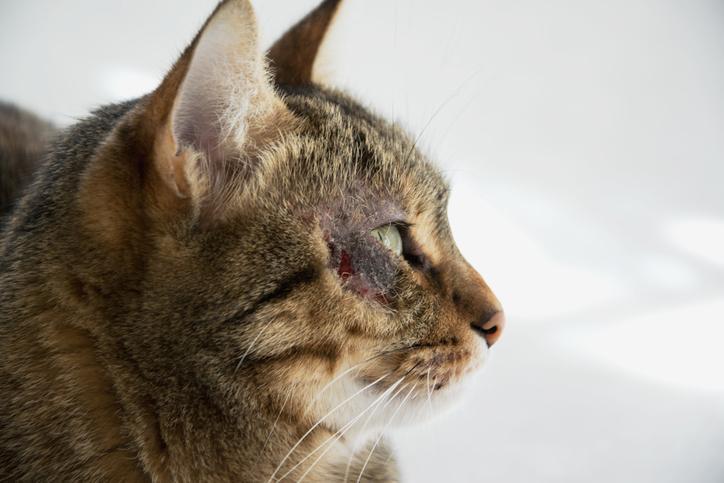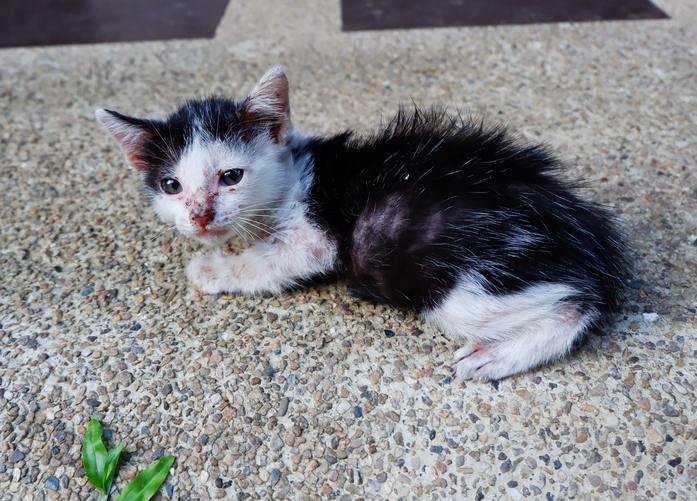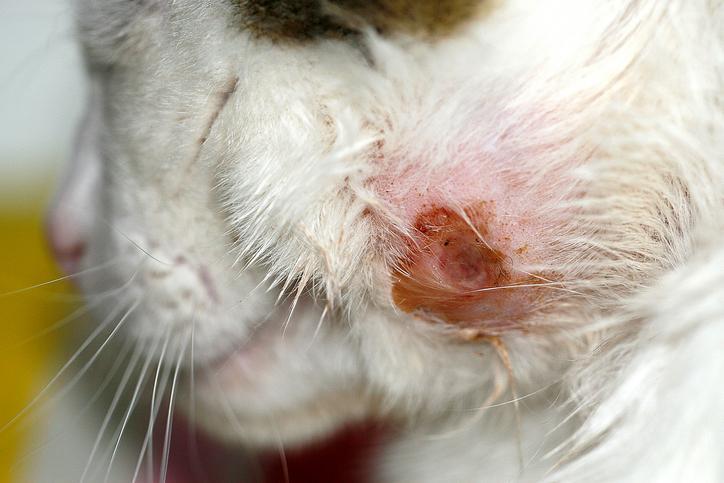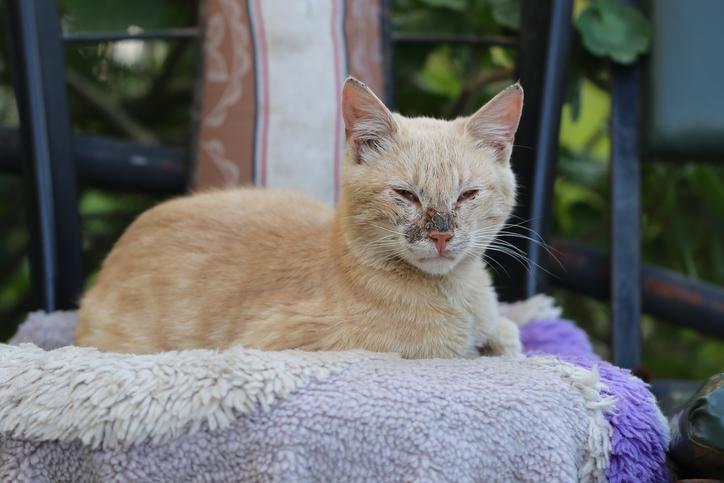Cat Wounds Causes and Care



See files for Cats
The causes of open wounds on cats are varied, but they are most commonly related to a trauma. These can range from being minor to life threatening, depending on the tissue affected, amount of blood loss and the risk of bacterial infection. If a bacterial infection does occur, the cat's open wound will likely abscess. This makes treatment more difficult and can result in sepsis which affects the cat's central nervous system.
At AnimalWised, we look in greater detail at the causes and care of cats wounds. We discover what to do if we see an open wound on a cat by treating it with first aid, as well as what to do if an abscess develops.
Bite wounds on a cat
The most common reason for a cat to have a skin wound is usually due to fights with other cats. Cats are territorial animals and will defend their area if they perceive another cat as a threat. Male cats, especially if they are unneutered, are more prone to fighting. Hormonal changes can make them more aggressive, particularly when there is a female cat in heat nearby. Sometimes cats may engage in play fighting that can escalate and result in superficial wounds.
In most cases, the wounds from these fights are superficial, and often one cat will scare off the other without an actual fight taking place. However, when fights occur and injuries happen, there can be complications. The main issues arise from improper healing or infection of the wounds. This can lead to the formation of a feline percutaneous abscess, which requires drainage and treatment. However, many cat bites and scratches will scab over and heal without major problems.
If you notice an open wound on your cat, you can clean it with a suitable feline disinfectant. But if the wound is deep or if there are signs of an abscess, it's best to take your cat to the vet. The vet may need to stitch the wound, drain any abscess, or prescribe antibiotics to prevent infection. For more information on treating superficial wounds in cats, you can refer to an article on feline first aid that provides guidance on feline-friendly disinfectants.
Cats that have been involved in car accidents and suffered blunt force trauma may also have skin wounds. Even if there are no obvious wounds, it's important to take a cat hit by a car to the vet. Internal injuries or brain injuries may not be immediately apparent but should be evaluated by a professional.
Learn how to intervene when necessary to prevent skin wounds in cats with our article on whether male cats are fighting or playing.
Skin conditions in cats
Wounds on a cat's skin can also occur due to skin conditions which can result in infections or other problems. While these conditions don't directly cause wounds, they can lead to scratching or biting, resulting in open wounds on the cat. This can cause alopecia (hair loss in cats), cuts, sca or ulcers. Different skin reaction patterns have various causes, but the following are notable:
- Self-inflicted hypotrichosis: this disorder involves hair loss and can lead to a condition known as itchy facial dermatitis. Cats with this condition may develop wounds on their faces. It is commonly observed in Persian cats as idiopathic facial dermatitis, where the exact cause is unknown, making treatment challenging. Successful treatment with cyclosporine has been reported[1]. It tends to occur more frequently in younger cats.
- Miliary dermatitis: this skin reaction results in variable itching (pruritus) and manifests as tiny wounds on the skin, primarily on the neck and head. Scratching can lead to hair loss and other skin problems. Miliary dermatitis can develop due to allergic reactions, parasitic infestations, skin infections, and other causes.
- Eosinophilic granuloma complex: this is a type of skin reaction pattern that can present in different ways. It may include eosinophilic ulcers, but their intensity can vary. The most common manifestation is eosinophilic plaque, appearing as a rash that can develop into sore lesions. Hypersensitivity to mosquitoes can be a cause, but sometimes the skin condition is also idiopathic.
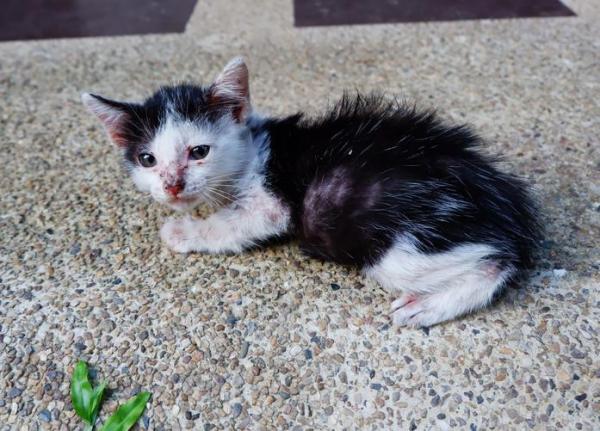
Wounds on a cat's skin caused by parasites
There are several types of parasite which can explain why our cat has wounds on their skin, whether open or scabbed over. The most common are:
- Fleas: these tiny insects jump from host to host and bite the skin to feed on blood. This process causes itching and it is common to result in wounds or alopecia. The lumbosacral area of the small of the back and neck are most commonly affected. The fleas and their remains can be seen with the naked eye and need to be treated with anti-parasitical products.
- Ticks: these arthropods mainly attack cats which have access to the outside world. If we do not see the cat being bitten by the tick, we might see evidence which suggests a bite site. These include areas with finer skin such as the ears, the neck or on the paws. We might see small bumps or even scabs on the cat's skin which correspond to the tick bite. It is necessary to see a veterinarian to confirm a feline tick bite if we suspect one.
- Mites: mites on cats are responsible for the disease scabies which is zoonotic (i.e. can be passed on to humans). it is characterized by intense itching, especially in the head region. However, it can migrate to other parts of the body. The mite Otodectes cynotis affects the ears, especially in younger cats. This can lead to otitis which produces a visible dark brown discharge. The Neotrombicula autumnalis shows itself as orange spots which cause a lot of itching and crusting. They can be eliminated with an anti-parasitic treatment once the vet has confirmed diagnosis.
In addition to otitis, you can learn about other common ear problems in cats with our related article.
Cat allergy wounds
A hypersensitivity to certain substances may explain why a cat has wounds on their skin. While we have already discussed how fleas can irritate a cat's skin, there is another way by which they can do the same. Some cats are allergic to the saliva of fleas and only a single bite can trigger a reaction which leads to wounds on their neck and lumbosacral area. This usually occurs between 3 and 6 years of age. As we state above, the use of antiparasitics is essential.
Atopic dermatitis has a genetic predisposition, but it can be stimulated by food borne allergens. In these cases, the vet will need to be seen to confirm a diagnosis and initiate the correct treatment. Atopic dermatitis usually appears in animals under 3 years of age. It will always be accompanied by itching, but may occur in a localized or generalized way. Coughing, sneezing or conjunctivitis may also occur. The diagnosis is confirm by an elimination diet where the allergen is detected.

Cat skin wounds due to infection
Both bacterial and fungal infections could be the root cause of skin wounds on a cat. Some of these infections also explain the presence of sores on the skin as happens with pyoderma (pustulous skin infections). There are too many possible skin infections to list here, but the following are some common offenders:
- Feline acne: this usually presents as black spots under the cat's chin, but can progress to pustules. This requires disinfection and veterinary treatment. It can appear at any age.
- Ringworm: probably the most well-known feline disease with the ability to infect humans. Although it usually presents as localized alopecia, it can also look very similar to miliary dermatitis or eosinophilic granuloma. It requires veterinary treatment and follow up hygiene measures to avoid contagion. It is most frequent in kittens, malnourished or sick cats.
- Panniculitis: the inflammation of adipose tissues which produces discharging ulcers. As there are several causes of this inflammation, treatment will depends on its origin.
Learn more about cat wound care and causes with our article on why my cat has scabs on their skin.
Skin wounds on cats with cancer
Some cancerous tumors in cats can also explain why a cat has wounds on their skin. Cats can get a type of malignant tumor known as a squamous cell carcinoma, something which usually appears on the nose, eyelids or ears. It is caused by the sun and is often localized to these areas as they are covered with the least hair. It first appears as a scab, but carcinoma can appear if the exposure is prolonged and treatment is not given.
Any eruption should be checked by the veterinarian as prognoses tend to improve with earlier diagnoses. It is necessary to keep the cat out of the sun and severe cases will require surgery. The risk heightens depending on the area on which it presents.

Diagnostic tests to see why a cat has skin wounds
Once we have seen the presence of wounds on a cat's skin, the vet will need to run diagnostic tests to discover the cause. They are the only ones who will be able to confirm a diagnosis, especially as many share symptoms. Among the tests to include are the following:
- Sampling
- Cutaneous (skin) scraping
- Ear examination
- Microscopic visualization of the hair
- Cytological study
- Observation with Wood's lamp
- Biopsy
- X-ray or sonogram
It is very important not to treat an animal with wounds on a cat's skin at home, other than aforementioned superficial cuts. This is because home treatment can often mean that the actual cause is not determined leading to a worsening of the clinical picture as well as the potential spread of many serious pathogens.
Treatment of cat wounds
The following are some possible cat wound care options for wounds and abscesses on a cat's skin according to their cause:
Wound leaning and topical treatments
- Cleaning: thoroughly clean the wound with a mild antiseptic solution recommended by your veterinarian to reduce the risk of infection.
- Topical antibiotics: apply a veterinarian-prescribed topical antibiotic ointment or cream to prevent infection and promote healing.
- Wound dressings: in some cases, a veterinarian may recommend the use of appropriate wound dressings to protect the wound and aid in healing.
Abscess treatment
- Drainage: if an abscess has formed, the veterinarian may need to drain the abscess to remove pus and promote healing. This is typically done under anesthesia.
- Antibiotics: depending on the severity of the abscess and the presence of infection, antibiotics may be prescribed to eliminate bacteria and prevent further complications.
- Warm compresses: applying warm compresses to the abscess can help promote drainage and relieve discomfort.
Parasite control
- Flea and tick treatment: administer appropriate flea and tick control products recommended by your veterinarian to eliminate parasites that may contribute to skin wounds or irritations.
- Mite treatments: specific antiparasitic medications or treatments may be necessary to address mite infestations, such as those caused by ear mites or demodectic mange in cats.
Allergenic reactions
- Identifying and eliminating allergens: work with your veterinarian to identify and eliminate potential allergens that may be triggering skin reactions and leading to wounds. This may involve dietary changes, environmental modifications, or allergy testing.
- Medications: depending on the severity of the allergic reaction, your veterinarian may prescribe medications such as antihistamines or corticosteroids to reduce inflammation and itching.
Bite wounds and fight injuries
- Veterinary examination: if your cat has been bitten by another cat or injured during a fight, it is important to have them examined by a veterinarian. The vet will assess the extent of the injury and may perform wound cleaning, administer antibiotics, and recommend pain relief measures.
- Surgical intervention: in severe cases, surgery may be required to repair extensive wounds or address deep tissue damage resulting from cat bites or other injuries.
It's important to consult with a veterinarian for proper diagnosis and individualized treatment recommendations based on the specific circumstances and condition of your cat.

Can you use Neosporin on a cat?
Neosporin is an over-the-counter topical ointment that contains the active ingredients bacitracin, neomycin and polymyxin B. It is primarily used for the treatment of minor cuts, scrapes and burns in humans.
While Neosporin can be safe for humans, it is generally not recommended for use on cat wounds without veterinary guidance. Cats may have a higher sensitivity to certain ingredients in Neosporin, particularly neomycin. Neomycin is an antibiotic that some cats can have an adverse reaction to, potentially causing skin irritation or even an allergic response.
If you notice a wound on your cat, it is best to consult a veterinarian for appropriate wound care. They can recommend veterinary-approved topical ointments or creams specifically formulated for cats. These products are designed to be safe and effective for feline use, minimizing the risk of adverse reactions.
It is crucial to remember that cats have unique physiology. Some substances that are safe for humans may not be suitable or safe for cats. It's always best to follow veterinary guidance when it comes to treating cat wounds or any other health concerns.
If you want to learn more about cat wound care, take a look at our article on why my cat's wound is not healing.

This article is purely informative. AnimalWised does not have the authority to prescribe any veterinary treatment or create a diagnosis. We invite you to take your pet to the veterinarian if they are suffering from any condition or pain.
If you want to read similar articles to Cat Wounds Causes and Care, we recommend you visit our Skin problems category.
1. Fontaine, J., & Heimann, M. (2004). Idiopathic facial dermatitis of the Persian cat: Three cases controlled with cyclosporine. Veterinary Dermatology, 15(s1), 64-64.
https://doi.org/10.1111/j.1365-3164.2004.00414_70.x



